HIV Warning Signs: What to Look Out For and When to Test
HIV often starts with mild symptoms that can easily be mistaken for the flu or fatigue, making early detection difficult without testing. However, catching the virus in its early stage is critical — both for protecting your health and reducing the risk of transmission. Knowing what to look for and when to get tested can make all the difference in timely diagnosis and treatment.

What are the first physical symptoms that may appear after HIV exposure?
The initial symptoms of HIV infection can manifest as early as 2 to 4 weeks after exposure. These symptoms are part of what’s known as acute HIV infection or acute retroviral syndrome. During this stage, the virus rapidly multiplies in the body, leading to a range of flu-like symptoms. Common early signs include:
-
Fever
-
Chills
-
Fatigue
-
Muscle aches
-
Sore throat
-
Headache
-
Rash
It’s important to note that not everyone experiences these symptoms, and they can vary in severity from person to person. Some individuals may not show any noticeable signs at all during the acute stage.
How does acute HIV infection commonly resemble the flu or a viral illness?
Acute HIV infection often mimics the symptoms of influenza or other viral illnesses, making it challenging to distinguish without proper testing. Both conditions can cause fever, fatigue, body aches, and general malaise. This similarity is one reason why many people may not immediately suspect HIV infection.
The flu-like symptoms associated with acute HIV typically last for a few weeks and then subside as the body’s immune system attempts to fight the virus. This period of apparent recovery can be misleading, as the virus continues to replicate and spread throughout the body, even in the absence of symptoms.
Why is monitoring swollen lymph nodes and night sweats important in early stages?
Swollen lymph nodes and night sweats are two important symptoms that can indicate an ongoing immune response to HIV infection. Lymph nodes are part of the body’s immune system and can become enlarged when fighting off infections. In the case of HIV, persistent swollen lymph nodes, particularly in the neck, armpits, or groin, may be a sign of the body’s ongoing battle against the virus.
Night sweats, characterized by excessive sweating during sleep, are another potential indicator of HIV infection. They can be caused by the body’s attempt to fight off the virus and regulate its temperature. While night sweats can have various causes, when combined with other HIV-related symptoms, they warrant attention and potential medical evaluation.
How can recurring infections or unexplained fatigue point to a weakened immune system?
As HIV progresses, it gradually weakens the immune system, making the body more susceptible to opportunistic infections and prolonged fatigue. Recurring infections that seem to happen more frequently or are harder to shake off can be a sign of a compromised immune system. These may include:
-
Frequent yeast infections
-
Persistent cold sores
-
Recurrent bacterial infections
-
Pneumonia
Unexplained fatigue that persists for weeks or months can also be a sign of HIV-related immune suppression. This fatigue is often described as overwhelming and not alleviated by rest. While fatigue can have many causes, when coupled with other HIV-related symptoms or risk factors, it should prompt consideration for HIV testing.
When is the right time to get tested after potential HIV exposure?
Determining the right time for HIV testing after potential exposure is crucial for accurate results. The window period – the time between potential exposure and when a test can reliably detect HIV – varies depending on the type of test used:
-
Nucleic Acid Tests (NAT): Can detect HIV as early as 10 to 33 days after exposure
-
Antigen/Antibody Tests: Can detect HIV 18 to 45 days after exposure
-
Antibody Tests: Can detect HIV 23 to 90 days after exposure
Generally, it’s recommended to get tested 3 to 4 weeks after potential exposure, with a follow-up test at 3 months for confirmation. However, if you’re experiencing acute HIV symptoms, it’s advisable to seek medical attention and testing immediately.
Regular testing is crucial for those at higher risk of HIV exposure. The Centers for Disease Control and Prevention (CDC) recommends that everyone between the ages of 13 and 64 get tested for HIV at least once as part of routine health care. Individuals with higher risk factors should consider more frequent testing, such as annually or every 3-6 months.
HIV testing is widely available through healthcare providers, clinics, and community health centers. Many locations offer free or low-cost testing options, making it accessible to most individuals.
In conclusion, understanding the warning signs of HIV infection and knowing when to get tested are crucial steps in maintaining your health and preventing the spread of the virus. While early symptoms can be subtle and easily mistaken for other illnesses, being aware of potential HIV exposure and seeking timely testing can lead to early diagnosis and treatment. Remember, HIV is manageable with proper medical care, and early detection significantly improves long-term health outcomes.
This article is for informational purposes only and should not be considered medical advice. Please consult a qualified healthcare professional for personalized guidance and treatment.




